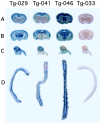Neuron-specific activation of murine cytomegalovirus early gene e1 promoter in transgenic mice
- PMID: 12875983
- PMCID: PMC1868196
- DOI: 10.1016/S0002-9440(10)63691-7
Neuron-specific activation of murine cytomegalovirus early gene e1 promoter in transgenic mice
Abstract
The brain is the main target in congenital cytomegalovirus (CMV) infection and immunocompromised patients. No definite evidence that a CMV has special affinity for the central nervous system (CNS) has been published. Here, we generated transgenic mice with an e1 promoter/enhancer region connected to the reporter gene lacZ. Surprisingly, expression of the transgene was completely restricted to the CNS in all lines of transgenic mice. The transgene was expressed in subpopulation of neurons in the cerebral cortex, hippocampus, diencephalon, brainstem, cerebellum, and spinal cord in all of the lines. Non-neuronal cells in the CNS were negative for transgene expression. Activation of the transgene was first observed in neurons of mesencephalon in late gestation, and then the number of positive neurons increased in various parts of the brain as development proceeded. Upon infection of the transgenic mouse brains with MCMV, the location of the activated neurons became more extensive, and the number of such neurons increased. These results suggest that there are host factor(s) that directly activate the MCMV early gene promoter in neurons. This neuron-specific activation may be associated with persistent infection in the brain and may be responsible for the neuronal dysfunction and neuronal cell loss caused by CMV infection.
Figures








Similar articles
-
Prolonged activation of cytomegalovirus early gene e1-promoter exclusively in neurons during infection of the developing cerebrum.Acta Neuropathol Commun. 2021 Mar 9;9(1):39. doi: 10.1186/s40478-021-01139-0. Acta Neuropathol Commun. 2021. PMID: 33750455 Free PMC article.
-
Activation of murine cytomegalovirus immediate-early promoter in mouse brain after transplantation of the neural stem cells.Acta Neuropathol. 2004 May;107(5):406-12. doi: 10.1007/s00401-004-0828-0. Epub 2004 Mar 23. Acta Neuropathol. 2004. PMID: 15042384
-
Mouse embryonic stem cells are not susceptible to cytomegalovirus but acquire susceptibility during differentiation.Birth Defects Res A Clin Mol Teratol. 2006 Feb;76(2):115-25. doi: 10.1002/bdra.20233. Birth Defects Res A Clin Mol Teratol. 2006. PMID: 16470616
-
Neuropathogenesis in cytomegalovirus infection: indication of the mechanisms using mouse models.Rev Med Virol. 2005 Sep-Oct;15(5):327-45. doi: 10.1002/rmv.475. Rev Med Virol. 2005. PMID: 16100703 Review.
-
[Murine cytomegalovirus for the animal models of congenital cytomegalovirus infection in human].Nihon Rinsho. 1998 Jan;56(1):90-6. Nihon Rinsho. 1998. PMID: 9465671 Review. Japanese.
Cited by
-
Temporal profiling of the coding and noncoding murine cytomegalovirus transcriptomes.J Virol. 2011 Jun;85(12):6065-76. doi: 10.1128/JVI.02341-10. Epub 2011 Apr 6. J Virol. 2011. PMID: 21471238 Free PMC article.
-
Prolonged activation of cytomegalovirus early gene e1-promoter exclusively in neurons during infection of the developing cerebrum.Acta Neuropathol Commun. 2021 Mar 9;9(1):39. doi: 10.1186/s40478-021-01139-0. Acta Neuropathol Commun. 2021. PMID: 33750455 Free PMC article.
-
Persistent humoral immune responses in the CNS limit recovery of reactivated murine cytomegalovirus.PLoS One. 2012;7(3):e33143. doi: 10.1371/journal.pone.0033143. Epub 2012 Mar 6. PLoS One. 2012. PMID: 22412996 Free PMC article.
-
The 6-Aminoquinolone WC5 inhibits different functions of the immediate-early 2 (IE2) protein of human cytomegalovirus that are essential for viral replication.Antimicrob Agents Chemother. 2014 Nov;58(11):6615-26. doi: 10.1128/AAC.03309-14. Epub 2014 Aug 25. Antimicrob Agents Chemother. 2014. PMID: 25155603 Free PMC article.
-
One of the Triple Poly(A) Signals in the M112-113 Gene Is Important and Sufficient for Stabilizing the M112-113 mRNA and the Replication of Murine Cytomegalovirus.Viruses. 2020 Aug 28;12(9):954. doi: 10.3390/v12090954. Viruses. 2020. PMID: 32872150 Free PMC article.
References
-
- Weller TH: The cytomegalovirus: ubiquitous agents with protean clinical manifestations. N Engl J Med 1971, 285:203-214 - PubMed
-
- Becroft DMO: Prenatal cytomegalovirus infection: epidemiology, pathology, and pathogenesis. Perspect Pediatr Pathol 1981, 6:203-241 - PubMed
-
- Stagno S, Pass RF, Cloud G, Bright WJ, Henderson RE, Walton PD, Veren DA, Page F, Alford CA: Primary cytomegalovirus infection in pregnancy: incidence, transmission to fetus, and clinical outocome. JAMA 1986, 256:1904-1908 - PubMed
-
- Ho M: Congenital and perinatal human cytomegalovirus infection. Ho M eds. Cytomegalovirus: Biology and Infection. 1991:pp 205-227 Plenum New York
-
- Pass RF, Stagno S, Myers GJ, Alford CA: Outcome of symptomatic congenital cytomegalovirus infection: results of long-term longitudinal follow-up. Pediatrics 1980, 66:758-762 - PubMed
Publication types
MeSH terms
Substances
LinkOut - more resources
Full Text Sources

